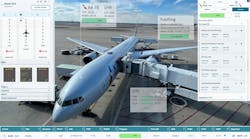UTC Aerospace Systems’ legacy Goodrich business was among the companies that pioneered health usage and management systems (HUMS) for military helicopters in the late 1990s and early 2000s, automating parametric sensor data collection and using this data to diagnose the health of mechanical drive train components. These systems integrated vibration sensor arrays with the aircraft avionics to allow the system to automatically recognize different aircraft states and flight regimes and capture data in each regime.
In 1999, the safety benefits derived from vehicle health management (VHM) systems and their ability to provide early identification of issues that result in catastrophic component failures prompted the UK’s Civil Aviation Authority’s (CAA) Safety Regulation Group to issue Additional Airworthiness Directives (AAD) regulatory compliance guidelines (CAP 693) mandating the use of VHM for civil transport helicopters operating in the North Sea. The AAD and certification guidelines were updated in 2006 when CAP 753 was released to address certification of VHM system design and operation.
HUMS today now provide automated power assurance checks, in-flight crew alerts when thresholds are exceeded, package data for evaluation by ground-based applications that feature automated rotor and shaft balance solutions, drivetrain and engine health assessments, and automate logbook entries for maintenance records. Fleet analytics tools are used to trend the health and usage of an aircraft and can compare this aircraft with others in the fleet for trend analysis. The UTC Aerospace Systems (UTAS) Vehicle Health Management System (IVHMS) has been credited by the Army with a 27 percent higher sortie rate compared with non-IVHMS equipped aircraft, a 52 percent reduction in unscheduled maintenance and a 17 percent reduction in total maintenance for the UH-60L Blackhawk.[1]
HUMS as an enabler to more efficient operations and lower sustainment costs – Compared with fixed-wing aircraft, helicopters have higher mechanical failure rates and operating costs. These factors, coupled with a requirement for improved safety of passenger-carrying helicopters, drove the requirements for mechanical diagnostics and the early adoption of HUMS in military helicopters. The benefits of vehicle health management systems are now being considered for commercial and business fixed wing aircraft to reduce unplanned maintenance and to improve dispatch reliability. For years, commercial aircraft have been linking engine usage and aircraft parametric data to ground bases for analysis, so how would vehicle health management systems be required? Consider for a moment, an automotive tire pressure monitoring system. The system is fully contained within the vehicle, to include a tire pressure warning light to alert the driver if he needs to stop and check his tires. This system also has pressure thresholds established to optimize fuel economy and the additional indirect benefit of preventing excessive tire wear caused by under-inflation. These features help save the motorist operating and maintenance costs. Translate that to an aircraft subsystem monitor; knowing that a key system is degrading or has failed can help aircrews make the decision to abort, divert, or even request an emergency landing. But the true efficiencies are gained when flight crews, ground operations, and maintenance centers can each view aircraft health data, presented in a manner that facilitates decisions:
Flight crews – on indication, crews can query system health in operation and make real-time decisions for events that could impact safety, performance, or passenger comfort.
Ground crews – can use mobile devices to query an aircraft and get a quick dashboard status on subsystems as the aircraft taxis to the gate or prior to the start of the day’s operations. Troubleshooting guides can be linked to mobile applications to expedite any required maintenance steps required.
Green systems – fully functional
Yellow systems – degraded below threshold but acceptable for operation
Red systems – failed and require maintenance
Maintenance centers – can trend system performance by tail number or across the fleet to incorporate degrading systems into the next planned maintenance window. Deeper analysis of developing indications can be correlated to usage, events, or rate of the failure progression.
Advancements in sensor and processing technologies are now enabling providers like UTC Aerospace Systems to field more efficient, lighter health management solutions that can be tailored to a specific aircraft subsystem. Beyond the traditional HUMS solutions for engine and drivetrain components, today’s vehicle health systems monitor targeted applications like pumps, generators, electro-mechanical actuators, and fans and compressors.
Applying health monitoring to a single subsystem or scaling to multiple systems requires a flexible, distributed architecture like UTC Aerospace Systems’ new Pulse™ Health Monitoring System, or PHMS, that can integrate large arrays of digital sensors and combine multiple sensor types to achieve a best-fit solution for each operator. In many cases, chronic maintenance issues have resulted in soft-life limits for entire fleets, where parts are replaced prior to failure based on hours accumulated, often replacing units that are still functioning normally. Through the use of a Pulse Health Monitoring System, maintenance action could be deferred until degradation of the unit is observed. Analytics from the system health monitor can also help display trends and identify causal factors for certain equipment failing prematurely due to regional usage or environmental factors. In such cases, the maintenance actions can be planned to accommodate these regional variations, scheduling spare parts and maintenance intervals appropriately.
Sensing and diagnostics needs may increase over the life of the aircraft, so expandability and scalability are critical to recognizing full potential of a vehicle health monitoring system. The Pulse Health Monitoring System is a lightweight, distributed-architecture system that can take advantage of information from the aircraft digital data bus and integrate those parametric data points with arrays of analog and digital sensors. It is designed to be modular and scalable for efficient tailoring to a customer’s need. The UTC Aerospace Systems PHMS provides traditional sensing of vibration, speed, strain, temperature, pressure, position, and current, making it ideal for monitoring aircraft subsystems and drive trains, accessing existing sensor data. Alternatively, new, lightweight digital sensors can be added to monitor the targeted system. Miniaturization and current manufacturing advances allow these products to be offered at a fraction of the price and footprint of previous generation HUMS products, making them an affordable, easily installed option for small fleet operators. The PHMS is designed to perform the same onboard data analytics as traditional, larger health monitoring systems. Wireless data concentrators also offer the convenience of connecting modular sensor arrays to the onboard processor without the need to route additional harnesses, helping to save cost and weight for these systems.
Additionally, the PHMS offers the option for structural health monitoring by adding arrays of the UTC Aerospace Systems MD7-PRO™, an advanced structural health monitoring (SHM) sensing system, to automate and provide highly repeatable inspection of aircraft structures or skins. The SHM system adds capability to identify or trend fatigue and impact damage, monitor for corrosion cracking, identify loose fasteners, or composite bond line delamination. By permanently installing a lightweight, digital sensing array to directly metallic or composite structures, significant reductions in labor-intensive visual or other nondestructive inspections can be realized. This is a significant benefit for hard to access or concealed areas of an aircraft. The UTC Aerospace Systems Pulse Health Monitoring System can add a modular SHM function to offer both aircraft subsystems as well as structural monitoring. These tools offer ground crews the ability to efficiently query an aircraft on the ramp to determine if damage has occurred following a suspected hard landing or through contact with ground support/servicing equipment. This capability allows for quick response and minimizes dispatch delays related to troubleshooting or inspections.
The UTC Aerospace Systems PHMS offers state-of-the-art data download capability, with multiple transmission capabilities built into the unit. The data download can be requested using a variety of different criteria. This capability enables near-wing maintenance status review and cloud-based fleet management.
Realizing the Benefits
The culmination of prognostics and structural health monitoring systems comes through fusion of the data across all aspects of an aircraft lifecycle. Maintenance organizations receive actionable alerts while an aircraft is still in flight and are prepared with corrective actions when the aircraft arrives at an airport. User-friendly visual displays on mobile devices aid in assessing health and status of the aircraft and in aiding in the remediation process. Integrating tracking databases with maintenance information systems help operators track component time in service and document part history.
Ground operations staffs have real-time, precise feedback on the health of the entire aircraft, with links to troubleshooting and repair guides and service limits. These mobile applications are linked to central maintenance systems to help automate just-in-time ordering of parts to align with scheduled maintenance periods at designated locations. This allows operators to optimize parts inventories and maximize the utilization of equipment and resources. Trending the condition of equipment results in early detection of issues and timely remediation, reducing more expensive, often unscheduled repairs.
About the author.
Kevin Hawko is the HUMS Business Development Manager at UTC Aerospace Systems. He joined his first Navy helicopter squadron in 1993 was a Naval Aviator until 2000 and was qualified as a maintenance check pilot.



